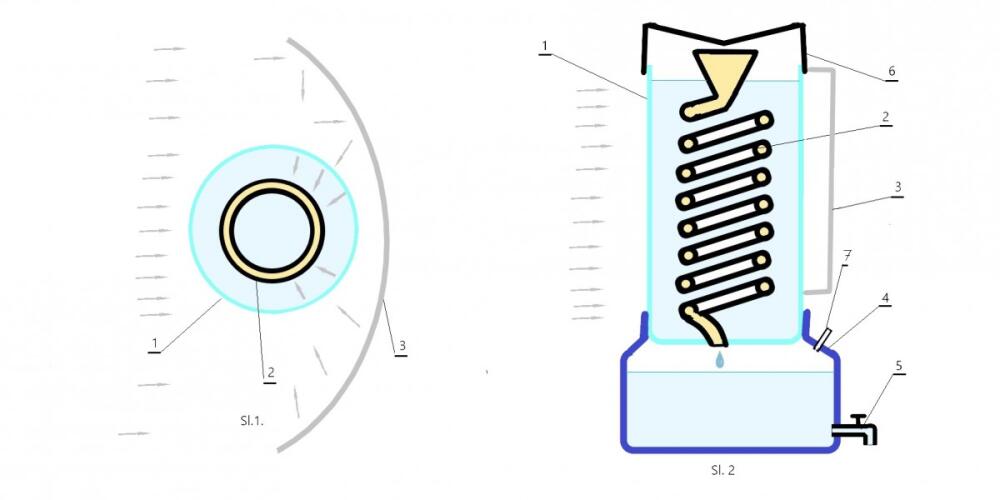
There are various types of seawater desalination devices for drinking water and plant irrigation. Most of these devices use a lot of energy to evaporate water and convert it into water vapor which is then condensed into liquid drinking water. Some devices are based on conducting water through special thin semi-permeable membranes during which the osmosis process takes place. This gives a certain amount of water without salt.
All these devices are too complex and expensive, both in the production of the devices themselves, and in everyday work.
In order for desalinators to be efficient and cost-effective, they must be as simple as possible, and without moving parts that need to be moved constantly.
The simplest distillation device is a brandy distillation boiler.
Following its example, it is possible to make a boiler that is heated by the sun, inside which there is a metal spiral tube through which water vapor descends, and by cooling it turns into pure water.
The device shown in the picture above is very simple.
The main part is a transparent tube (1) made of glass, or transparent plastic, which is placed perpendicular to the ground and inside which is sea water. This pipe should be at least 5 times higher than it is wide.
Above this pipe is a cover (6).
Inside the transparent tube (1) there is a spiral tube (2) whose upper part is located at the top of the transparent tube, and the lower part passes through the bottom of the transparent tube (1). Behind the transparent tube (1) is an aluminum sheet (3). When the sun illuminates the transparent tube (1), it is placed towards the sun so that the aluminum sheet (3) directs the sun's rays towards the spiral tube (2). In doing so, the spiral tube (2) is heated far above the ambient heat, and thus the seawater around this spiral tube (2) is also heated. This spiral tube (2) is made of metal and painted in a dark color that absorbs sunlight well. Heat is transferred from the spiral tube (2) to the surrounding seawater which heats up and evaporates. The hot water moves upwards, and thanks to this the water is warmest inside the transparent tube (1) at its top, while it is coldest at the bottom. The hot water evaporates, and this steam enters the spiral tube (2) from the top. When descending through the spiral tube (2), water vapor enters the area with a lower temperature, where it is cooled and condensed into water. The heat of the water vapor is transferred to the walls of the spiral tube (2) through which it heats the surrounding water inside the transparent tube (2). In this way, the heat used is reused to evaporate the seawater. The condensed water descends through a spiral pipe (2) and enters the drinking water storage (4) from where the user can take it by opening the tap (5). At the top and on the side of this drinking water tank (4) there is a small vent pipe (7) through which the internal pressure is equalized with the external pressure.
As the seawater inside the transparent tube (1) is converted into drinking water by evaporation, the seawater level inside the transparent tube (1) decreases. Therefore, a new amount of sea water should be added to it from time to time. This is done through the inlet pipe (8). Sea water is poured into this inlet pipe (8) from above and is passed through it to the bottom of the transparent pipe (1). In doing so, it cools the water already at the bottom of the transparent tube (1) and the seawater at the top of the transparent tube still remains hot and evaporates strongly.
After some time, the amount of salt inside the transparent tube (1) would increase, and the salt would begin to form crystals. Then the transparent tube (1) should be emptied and new sea water poured in. Spilled seawater with a high concentration of salt that began to form crystals could be used to salt food, and additional evaporation could give pure solid crystallized salt.
Such a solar desanalyzer could be very useful as a small handy tool on lifeboats, on ocean-going ships, and on small islands where there is no source of drinking water. The user should only occasionally turn it towards the sun, and add water. Such a larger desalinator could be used to irrigate plants near the sea shore, in which case turning to the sun and adding new seawater could be automated with energy obtained from a small photocell.
My other innovations can be seen in this book.
Tags
Featured articles